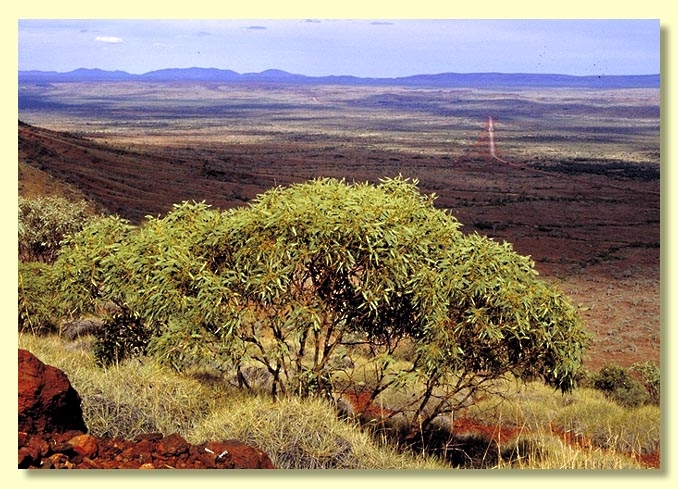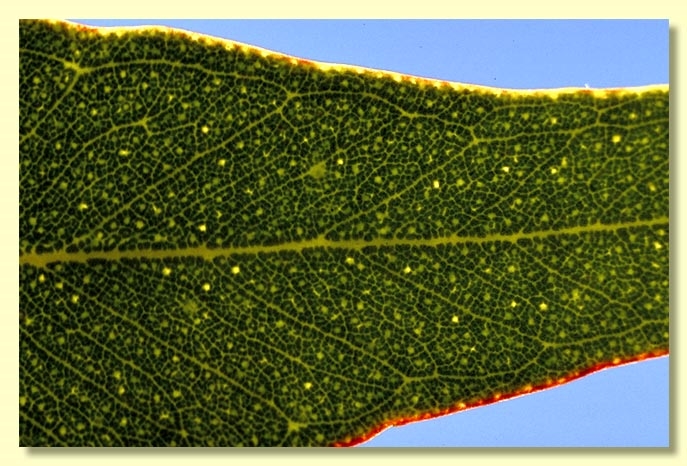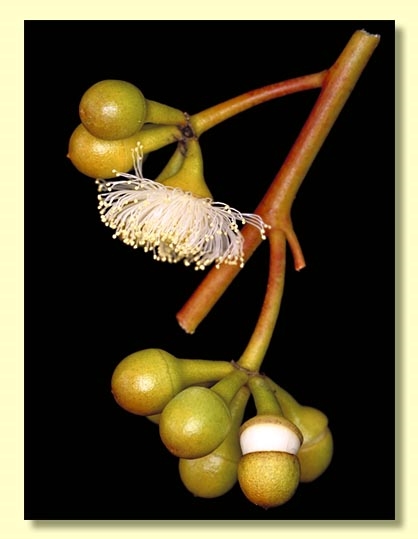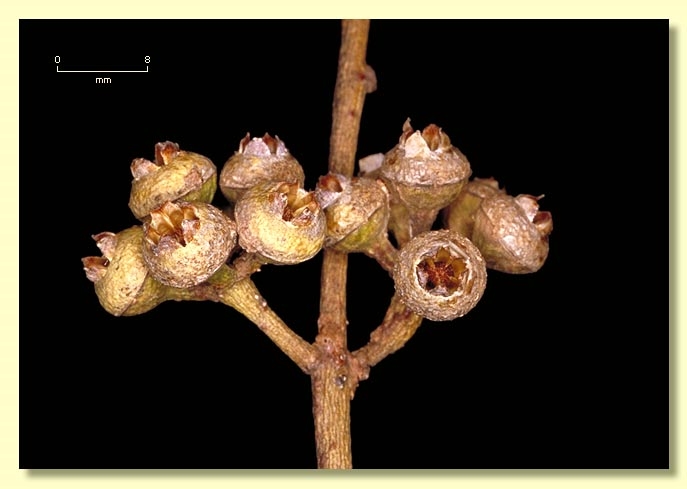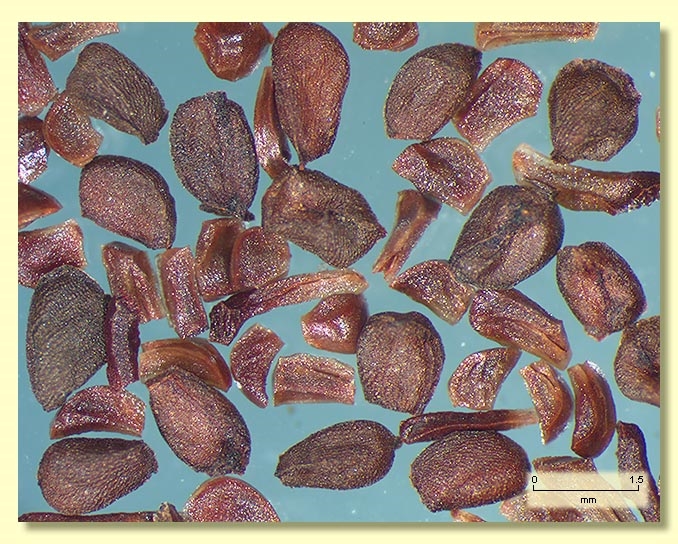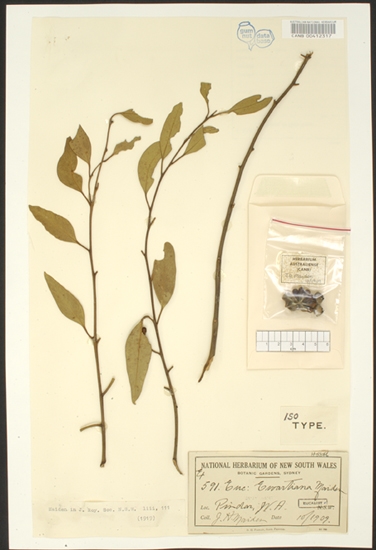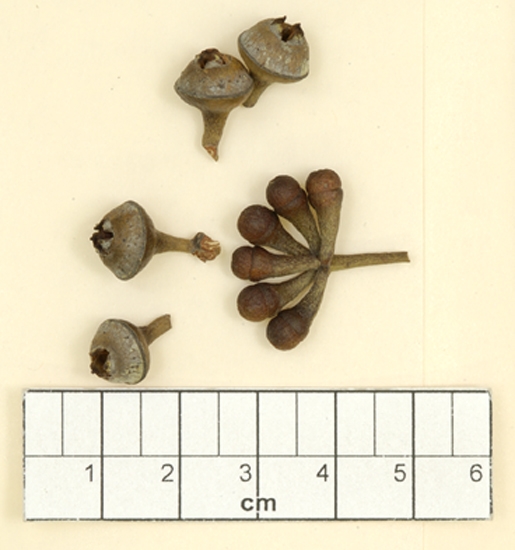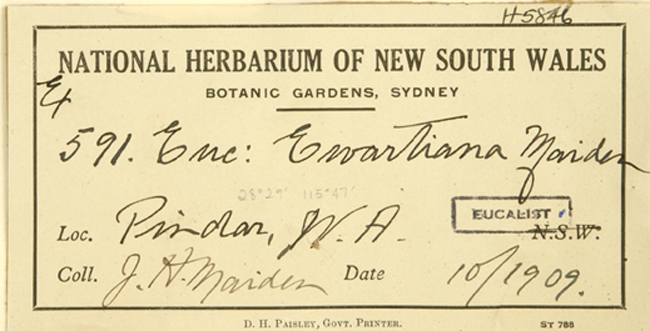Eucalyptus | Symphyomyrtus | Bisectae | Destitutae | Curviptera | Orbifoliae
Euclid - Online edition
Eucalyptus ewartiana
Bark minnirichi throughout, greyish over red-brown or green-brown, or, less commonly, partly rough, matted and fibrous on basal 1 m of largest trunks.
Branchlets lacking oil glands in the pith.
Juvenile growth (coppice or field seedlings to 50 cm): stems rounded in cross-section; juvenile leaves always petiolate, opposite for lowest node then alternate, ovate, 5–8 cm long, 1.5–5 cm wide, dull, greyish green.
Adult leaves alternate, petioles 0.7–2.5 cm long; blade ovate to lanceolate, sometimes narrowly so, (3.8)4.5–9.5 cm long, 1–3(4) cm wide, base tapering to petiole, margin entire, apex acute, concolorous, thickish, dull, green or greyish green, side-veins usually greater than 45° to midrib, rarely acute, reticulation dense, intramarginal vein close to margin, oil glands intersectional, irregular to round.
Inflorescence axillary unbranched, peduncles 0.5–2 cm long, buds 7 per umbel, rarely 9 or 11, pedicels 0.3–0.7 cm long. Mature buds globular to ovoid (0.6–0.9 cm long, 0.5–0.7 cm wide), scar present, operculum rounded (0.2–0.5 cm long), stamens obliquely erect, or some inner stamens distally deflexed, anthers cuboid, versatile, basifixed, dehiscing by longitudinal slits, style long and straight, stigma blunt, locules 4(5), the placentae each with 4 vertical rows of ovules with a central gap. Flowers white.
Fruit pedicellate (pedicels 0.1–0.9 cm long), shallowly and broadly obconical to hemispherical, 0.2–0.6 cm long, 0.7–1.3 cm wide, disc steeply ascending, valves 4(5), prominently exserted.
Seeds dark brown to grey-brown, 0.8–2 mm long, angularly ovoid to almost cuboid, scarcely ribbed ventrally, dorsal surface conspicuously but shallowly reticulate, hilum ventral or terminal.
Cultivated seedlings (measured at node 10): cotyledons Y-shaped (bisected); stems rounded in cross-section; leaves always petiolate, opposite for 4 to 6 nodes then alternate, ovate, 4–8.5 cm long, 2.5–4.5 cm wide, dull bluish green.
Flowering has been recorded in February, March, August and November.
A mallee endemic to Western Australia, widespread in the northern wheatbelt and east into the western fringes of the Great Victoria Desert, from Mt Meharry in the Pilbara south to Morawa, south-east to Beacon and inland to Paynes Find, Menzies and Cosmo Newberry. The Pilbara populations occur on mountaintops whilst further south the species occurs on loamy to sandy soils. The bark is minnirichi, adult leaves are dull, light green to blue-green, and buds globular to ovoid.
Eucalyptus ewartiana belongs in Eucalyptus subgenus Symphyomyrtus section Bisectae subsection Destitutae because buds have two opercula, cotyledons are Y-shaped and branchlets lack oil glands in the pith. Within this subsection E. ewartiana is in series Curviptera, one of about 30 closely related species and subspecies which are further characterised by having large buds in umbels of one, three or seven or rarely more; staminal filaments erect or oblique (rarely inflexed) in bud; and large fruit usually with an ascending disc and exserted valves.
Within the series Curviptera this species is most closely related to E. crucis, E. websteriana, E. orbifolia and E. educta, together forming a sungroup, subseries Orbifoliae. All have minnirichi bark, buds in umbels of three or seven (rarely eleven). All have stamens arranged obliquely in bud except E. educta, which has erect stamens. All have seed that are angularly ovoid though scarcely ridged. E. ewartiana differs from the other species by the combination of these features—alternate ovate to lanceolate non-glaucous crown leaves, non-glaucous branchlets, non-glaucous buds.
It is similar to E. glomerosa, and until recently South Australian populations of that species were regarded as being E. ewartiana. E. glomerosa differs profoundly in seed shape, having obliquely distorted seed with a tongue-like flange on one end; bark which is matted and fibrous, not minnirichi; and the base of the fruit which is flattish, not tapered.

